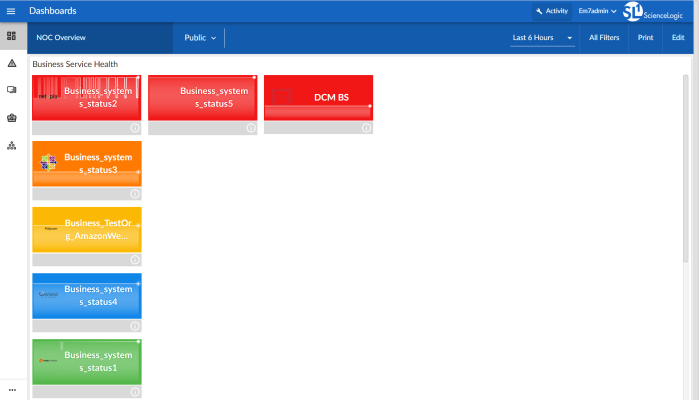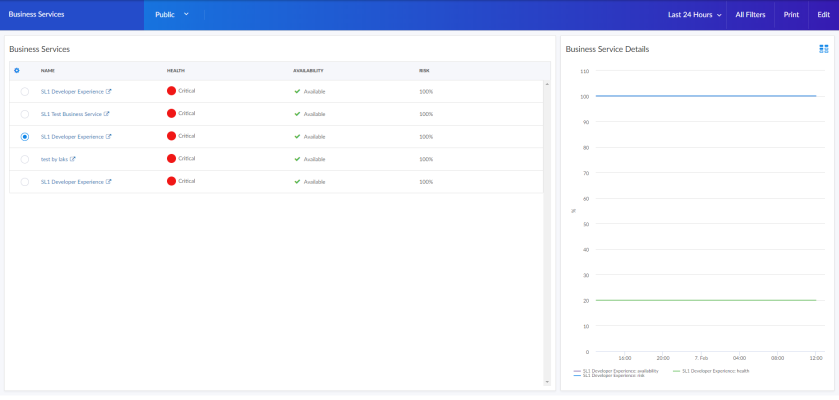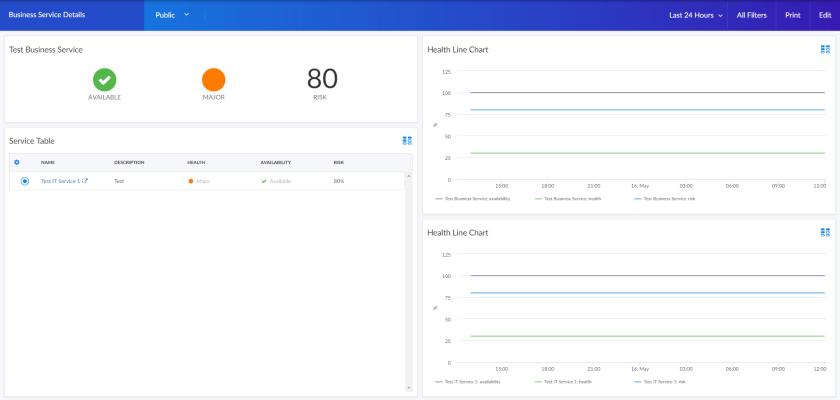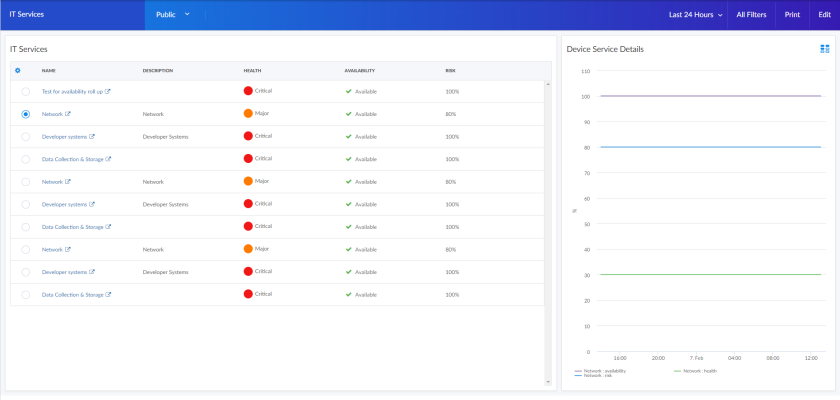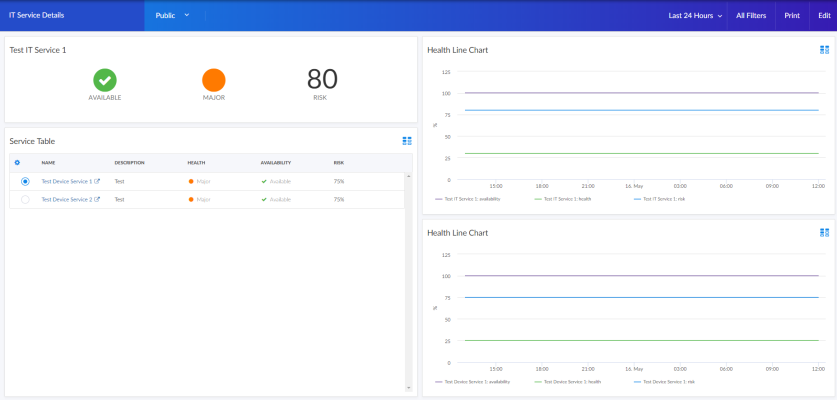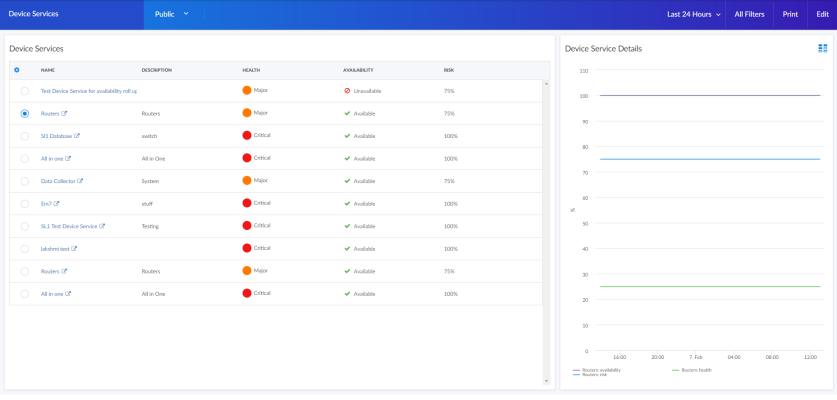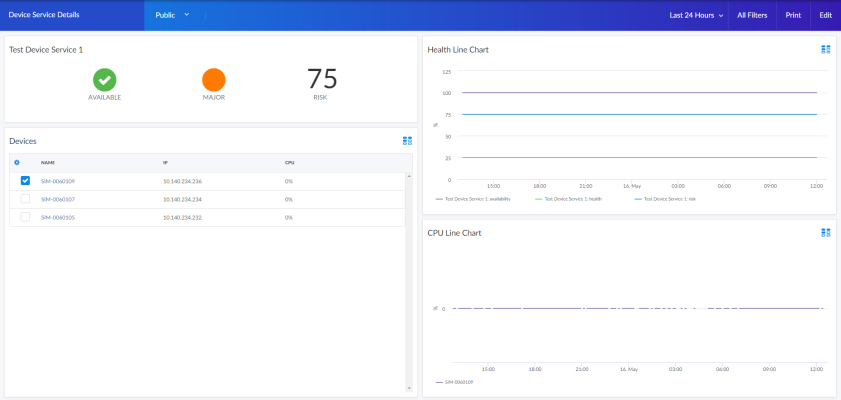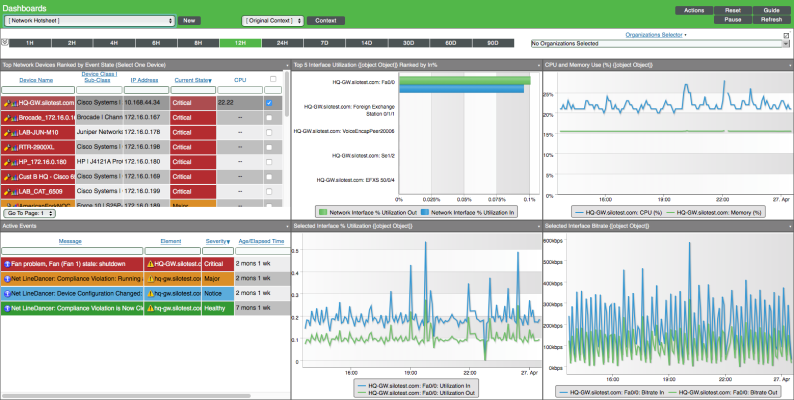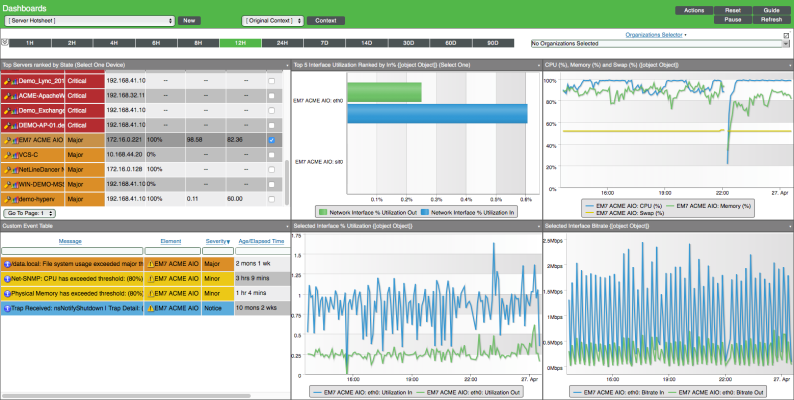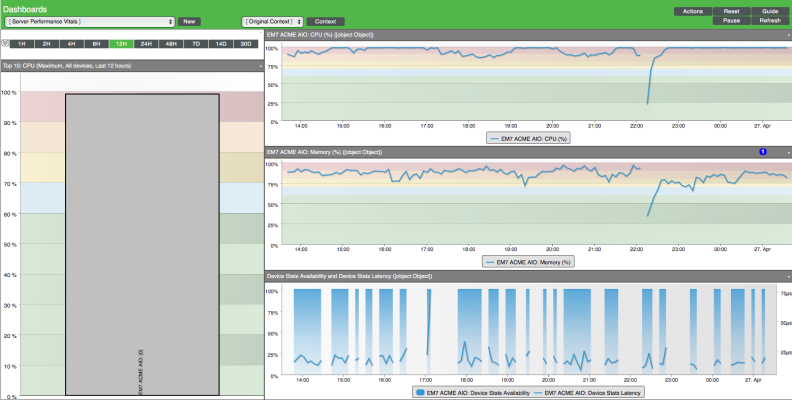This
You can view default dashboards on the Dashboards page, which you can access by clicking the Dashboards icon ().
You can also view default dashboards for the "classic" user interface on the Classic Dashboards page (Dashboards > Classic Dashboards).
Use the following menu options to navigate the SL1 user interface:
- To view a pop-out list of menu options, click the menu icon (
).
- To view a page containing all the menu options, click the Advanced menu icon (
).
This
Default Dashboards
This section describes the default dashboards that are available on the Dashboards page.
NOC Overview Dashboard
The NOC Overview dashboard displays a high-level overview of your Business Services and their current health statuses in a single-pane view:
This dashboard displays a series of color-coded tiles for each of your Business Services. The dashboard is updated in real time to reflect the most recent information about each service.
The dashboard displays services based on their health and availability status, ranging from "critical" displaying with a red background at the top of the dashboard to "healthy" displaying with a green background at the bottom. Services that become unavailable also display with a red background, similar to those with a "critical" health status. This color-coordinated hierarchy enables you to quickly see which services most require your attention.
Each tile includes the following information:
- The service's name and icon, if applicable
- A background color indicating the service's current health status
- A line chart indicating the service's health over the selected time period
Click a service tile to go to the Service Investigator page for that service, where you can view more information about the service and its health.
For more information about Business Services, see
Business Services Dashboard
The Business Services dashboard displays Availability, Health, and Risk data for all of your Business Services:
This dashboard includes the following widgets:
- Business Services. Displays a list of business services and their health, availability, and risk. Clicking the link icon (
) next to a service opens a Business Service Details dashboard for that service.
- Business Service Details. Displays the health, availability, and risk in a line chart for the service you selected the Business Services widget.
Business Service Details Dashboard
The Business Service Details dashboard provides an overview of the services that belong to a specific business service:
This dashboard includes the following widgets:
- Service View. Displays health, availability, and risk icons for that service.
- Health Line Chart. Displays a line chart of the service's health, availability, and risk.
- Service Table. Display a table of services with a description, health, availability, and risk. Clicking the link icon (
) next to a service opens a Details dashboard for that service.
- Health Line Chart. Selecting a service from the IT Services widget will display a line chart of health, availability, and risk for that service.
IT Services
The IT Services dashboard displays Availability, Health, and Risk data for all of your IT Services:
This dashboard includes the following widgets:
- IT Services. Displays a list of IT services and their health, availability, and risk. Clicking the link icon (
) next to a service opens an IT Service Details dashboard for that service.
- IT Service Details. Displays the health, availability, and risk in a line chart for the service you selected the IT Services widget.
IT Service Details Dashboard
The IT Services dashboard provides an overview of the device services that belong to a specific IT service:
This dashboard includes the following widgets:
- Service View. Displays health, availability, and risk icons for that service.
- Health Line Chart. Displays a line chart of the service's health, availability, and risk in a line chart.
- Service Table. Displays a tile view of device services.
- Health Line Chart. Selecting a service from the Device Services widget will display a line chart of health, availability, and risk for that service.
Device Services Dashboard
The Device Services dashboard displays Availability, Health, and Risk data for all of your Business Services:
This dashboard includes the following widgets:
- Device Services. Displays a list of device services and their health, availability, and risk. Clicking the link icon (
) next to a service opens a Device Service Details dashboard for that service.
- Device Service Details. Displays the health, availability, and risk in a line chart for the service you selected the Device Services widget.
Device Service Details Dashboard
The Device Service Details dashboard provides an overview of the devices that belong to a specific device service:
This dashboard includes the following widgets:
- Service View. Displays health, availability, and risk icons for that service.
- Health Line Chart. Displays a line chart of the service's health, availability, and risk.
- Devices. Displays a table of devices with their state and CPU usage.
- CPU Line Chart. Selecting a device from the devices table will populate this line chart with that device's CPU and memory utilization percentage.
Server Dashboard
The Server Dashboard displays CPU usage, memory usage, disk usage, and other widgets related to servers:
This dashboard includes the following widgets:
- Server Leaderboard. Displays a table of servers and their status, average swap, average memory, and average CPU usage.
- CPU Usage. Displays the total amount of CPU currently being used, as a percentage of all available CPU.
- Memory Usage. Displays total memory usage over time, in percent.
- Disk Usage. Displays total disk usage over time, in percent.
- Swap. Displays the total amount of swap space currently being used, as a percentage of all available swap.
- Total Network Traffic. Displays the total traffic for all inbound and outbound interfaces for each selected server, in Megabytes.
- Latency. Displays latency for the device in milliseconds. Latency means the amount of time it takes SL1 to communicate with the device.
- Availability. Availability means the device's ability to accept connections and data from the network. The possible values are "Available" and "Unavailable".
Default Classic Dashboards
After you have completed a discovery session that includes at least one server and one network device, such as an SNMP switch or router, the following dashboards appear on the Classic Dashboards (Dashboards > Classic Dashboards). You can access these dashboards from the Select Dashboard drop-down list in the top-left corner of the Classic Dashboards (Dashboards > Classic Dashboards).
Network Hotsheet
The Network Hotsheet dashboard provides an overview of the health and utilization of your network devices.
The dashboard includes the following widgets:
- Context Quick Selector. This widget allows the user to set the timespan for the dashboard.
- Organization Selector. This widget allows the user to specify the organization(s) to include in the dashboard.
- Top Network Devices Ranked by Event State. This widget displays a list of your network devices ranked by event state, from Critical to Healthy. Use the check boxes in the right-most column to select one or more devices. When you do so, the other widgets in the dashboard display information for the selected device(s).
- Top 5 Interface Utilization Ranked by In%. When you select one or more devices in the Top Network Devices Ranked by Event State widget, this widget displays a graph with the top five interfaces for the selected device(s) ranked by percentage of inbound network utilization. Each interface includes two bars graphs indicating inbound and outbound utilization. Select a particular interface by clicking either of its bars. When you do so, the Selected Interface % Utilization and Selected Interface Bitrate widgets display information for only the selected interface.
- CPU and Memory Use (%). When you select a single device in the Top Network Devices Ranked by Event State widget, this widget displays a graph with two lines indicating CPU usage and memory usage by percentage for the selected device over the specified timespan.
- Active Events. When you select one or more devices in the Top Network Devices Ranked by Event State widget, this widget displays a list of active events associated with the selected network device(s).
- Selected Interface % Utilization. When you select an interface in the Top 5 Interface Utilization Ranked by In% widget, this widget displays a graph with two lines indicating the inbound and outbound network utilization for the selected interface over the specified timespan.
- Selected Interface Bitrate. When you select an interface in the Top 5 Interface Utilization Ranked by In% widget, this widget displays a graph with two lines indicating the inbound and outbound bitrate for the selected interface over the specified timespan.
Server Hotsheet
The Server Hotsheet dashboard provides an overview of the health and utilization of your servers.
The dashboard includes the following widgets:
- Context Quick Selector. This widget allows the user to set the timespan for the dashboard.
- Organization Selector. This widget allows the user to specify the organization(s) to include in the dashboard.
- Top Servers Ranked by State. This widget displays a list of your servers ranked by event state, from Critical to Healthy. Use the check boxes in the right-most column to select one or more servers. When you do so, the other widgets in the dashboard display information for only the selected server(s).
- Top 5 Interface Utilization Ranked by In%. When you select one or more servers in the Top Servers Ranked by State widget, this widget displays a graph with the top five interfaces for the selected server(s) ranked by percentage of inbound network utilization. Each interface includes two bars graphs indicating inbound and outbound utilization. Select a particular interface by clicking either of its bars. When you do so, the Selected Interface % Utilization and Selected Interface Bitrate widgets display information for only the selected interface.
- CPU (%), Memory (%), and Swap (%). When you select a single server in the Top Servers Ranked by State widget, this widget displays a graph with three lines indicating CPU usage, memory usage, and swap usage by percentage for one selected server over the specified timespan.
- Custom Event Table. When you select one or more servers in the Top Servers Ranked by State widget, this widget displays a list of active events associated with the selected server(s).
- Selected Interface % Utilization. When you select an interface in the Top 5 Interface Utilization Ranked by In% widget, this widget displays a graph with two lines indicating the inbound and outbound network utilization for the selected interface over the specified timespan.
- Selected Interface Bitrate. When you select an interface in the Top 5 Interface Utilization Ranked by In% widget, this widget displays a graph with two lines indicating the inbound and outbound bitrate for the selected interface over the specified timespan.
Server Performance Vitals
The Server Performance Vitals dashboard provides an overview of the performance of your servers.
The dashboard includes the following widgets:
- Context Quick Selector. This widget allows the user to set the timespan for the dashboard.
- Top 10: CPU. This widget displays a column graph indicating the top 10 servers ranked by maximum CPU usage over the specified timespan. Select a particular server by clicking its column. When you do so, the other widgets in the dashboard display information for only the selected server.
- CPU (%). When you select a server in the Top 10: CPU widget, this widget displays a line graph indicating the CPU usage percentage for the selected server over the specified timespan.
- Memory CPU (%). When you select a server in the Top 10: CPU widget, this widget displays a line graph indicating the memory usage percentage for the selected server over the specified timespan.
- Device Stats Availability and Device Stats Latency. When you select a server in the Top 10: CPU widget, this widget displays a graph with two lines indicating the availability and latency statistics for the selected server over the specified timespan.
